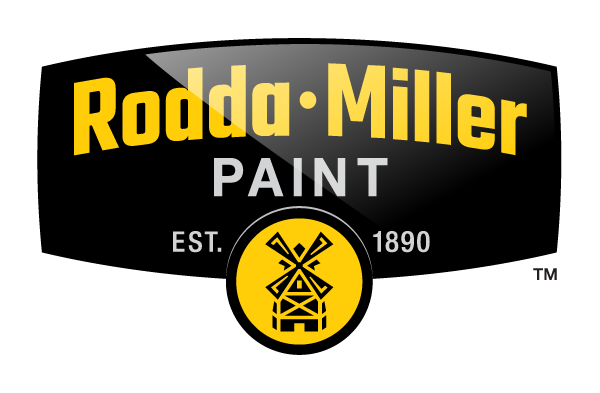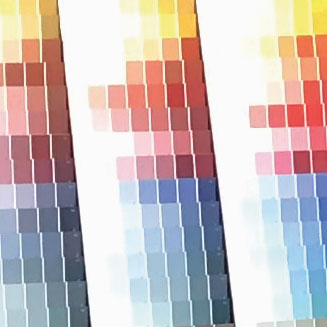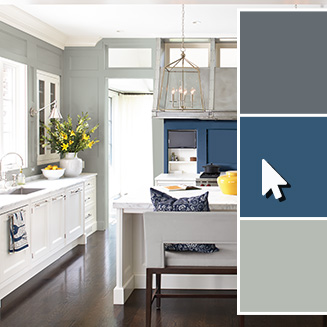STEP 1 – Choose the Right Paint
A home’s exterior is key for curb appeal and can make or break that all-important first impression of the house, so it’s vital to choose the highest-quality paint possible. To truly transform a home, and make the curb appeal of your home last for a long time, we recommend selecting premium paint, which provides a smoother, more uniform appearance, as well as better durability than economy paint. By using premium paint, your project will likely require fewer coats to give your home the protection it deserves. Also, you won’t have to repaint as frequently.
SELECTING THE RIGHT GLOSS
The gloss level you choose for your paint project can have a significant impact on both appearance and maintenance. To determine the right sheen for your exterior project, consider these factors:
STEP 2 – Choose the Right Primer
Priming is a key step in painting. Priming before painting ensures superior adhesion of the paint to the surface. It also helps cover darker-colored paints and stains, and creates a smoother, more even finish. There are many different types of primers, each suited for a particular surface, such as drywall, metal or concrete, etc. or to address a particular problem, such as to cover up stains or to prevent tannin bleeding, etc. Rodda Paint offers the following premium exterior primers for each surface type:
WOOD
PrimeSolution First Coat Primer is a high-hiding, low VOC waterborne acrylic primer for use on a variety of previously painted or new exterior and interior surfaces, while PrimeSolution Control Primer is a high-hiding, low VOC waterborne alkyd primer for use on a variety of previously painted or new exterior and interior surfaces that provides excellent enamel holdout and tannin stain resistance on woods such as redwood and cedar, that are typically subject to stain bleeding.
BLOCK FILLER
Sprayable Latex Block Filler is a heavy-bodied acrylic latex primer/filler that fills and bridges voids and cracks in porous cinder blocks and concrete blocks.
MULTI-PURPOSE
PrimeSolution First Coat Primer is an acrylic multi-purpose primer that provides superior adhesion, outstanding stain-blocking, excellent enamel holdout and great hide.
MASONRY
PrimeSolution First Coat Primer is an acrylic latex primer/sealer that provides superior adhesion and outstanding resistance to efflorescence and alkali.
Surf Bond II Primer is a lightly pigmented acrylic bonding primer/masonry conditioner for use as a first coat on masonry surfaces. It is designed to be an excellent conditioner that enhances the adhesion and resists efflorescent salts from showing through topcoats. Suitable for use on surfaces with a pH reading from 6 to 13.
FORMWORX/pHlex-Tite XL is a water-based, single-component, exterior, Acrylic, Elastomeric waterproofing concrete/masonry primer and finish that provides superior adhesion and outstanding alkali resistance. Perfect for use on high pH (6 – 13) surfaces, it can be readily top coated with itself or any Rodda Paint exterior acrylic coating.
METAL
PROTECH/Metal Master Primer is a Rust Preventative primer utilizing acrylic waterborne technology with excellent adhesion and corrosion resistance on exterior ferrous and non-ferrous metals, including galvanized steel, aluminum and more.
Barrier III Metal Primer is a solvent-borne, Rust Preventative primer utilizing alkyd technology that offers excellent adhesion and corrosion resistance on exterior ferrous metals.
STEP 3 – Estimate the Correct Amount of Paint
You can get a fairly accurate idea of how much paint you’ll need for your project using this simple calculator.
PAINT CALCULATOR
How much paint do you need? Complete our step-by-step calculator to find out.
View Paint Calculator
STEP 4 – Buy the Right Tools
We’ve created this simple checklist of the tools you should have for your exterior project:
Dust Mask to protect your lungs from fine particles
Goggles to protect your eyes
Sandpaper and Sanding Block to rough up shiny areas and smooth any rough spots
Wire Brush or Paint Scraper to remove loose paint
Flexible Patching and Putty Knife to fill small holes and cracks in wood and smooth concrete
Caulk and Caulking Gun to replace missing or damaged caulk around doors and windows
Stucco Patch and Rubber Float to repair small holes in stucco
Masking Tape and Masking Paper to protect glass and fixtures
Drop Cloths to cover the floor, carpet, furniture and other areas
Wall Brush for “cutting in” around corners, windows and doors
Sash Brush for painting trim
Roller Cover and Roller Frame for painting all of the large, flat surfaces inside your home
Bucket to mix your paint
Extension Pole to paint those hard-to-reach areas and finish your job faster
Wiping Cloths/Rags to clean up any spills
STEP 5 – Prepare to Paint
Weather and natural elements are unkind to home exteriors and over time, can severely damage paint, therefore, proper surface preparation is essential to achieve the best results. This begins by identifying and addressing the source of any problems before painting and using a primer if surfaces are unpainted or the original paint is in poor condition.
- Cut back shrubs and plants so they are easier to cover, but do not leave plants covered for too long or they might get damaged.
- Cover all objects and surfaces not being painted with plastic and make sure to move any cars away from the painting area.
- Clean gutters and downspouts.
- Wash the area beneath the roof eaves to remove any dirt and surface contaminants.
- Wear goggles and protective clothing. Rinse the area thoroughly with clean water.
- Remove surface dust and dirt using a cloth or soft brush and soapy water. Remove all stains, such as chalking and mildew.
- Repair all voids, cracks and holes.
- Sand all surfaces to smooth them out and use a wire brush or paint scraper to remove loose paint.
- Caulk all surface joints, cracks and seams. Make sure the caulking is thoroughly dry before painting. When working with bare surfaces, prime before applying caulk.
- Fill any cracks or large holes with a flexible patching material. Allow the patching material to dry completely before applying primer.
- Prime any areas that have not been previously painted or any exposed areas where paint has worn thin or has peeled or blistered. Allow all areas to dry thoroughly – one or two days may be necessary, depending on the primer used.
- Prime gutters and downspouts. If, gutters and downspouts have been painted previously, remove any rust and peeling paint using a scraper or wire brush. Sand all edges and wash the area with a garden hose or power washer.
- New aluminum gutters and downspouts that are factory-finished should remain in good condition for several years.
- New unpainted galvanized gutters and downspouts are coated with an oil that must be removed prior to painting… To remove the oil, use a moistened rag with a solvent or a water-soluble degreasing cleaner and thoroughly wipe all surfaces.
You are now ready to paint! Apply the appropriate paint for your situation as recommended in Step 1: Choosing the Right Paint.
CAUTION: Scraping or sanding surfaces of older buildings (especially pre-1978) may release dust containing lead or asbestos. EXPOSURE TO LEAD OR ASBESTOS CAN BE VERY HAZARDOUS TO YOUR HEALTH. Always wear appropriate personal protective equipment during surface preparation and finish clean-up of any residue by water-washing all surfaces. For more information, see Dunn-Edwards’ brochure on “Surface Preparation Safety” or call EPA’s National Lead Information Center at 1-800-424-LEAD, or visit or , or contact your state or local Health Department.
If you have additional questions, please ask any of our expert sales associates.
STEP 6 – Paint
When painting a house, it’s best to follow a time-tested plan.
First, remove shutters and screens where possible. Start with the walls, then the trim. Follow up with the railings, porches, steps, foundation and shutters. Start on the shaded side and never work in direct sunlight.
If you are using oil-based products, check that all dew has evaporated.
As you begin each section, arrange your drop cloths to shield plants and other areas. Cover shrubs crowding the house and pull them away from the house using staked ropes.
Fill the brush by dipping it one-third of the length of the bristles. Tap it gently against the side of the can, but don’t wipe the brush against the lip. The bristles should flex slightly as you paint (don’t press hard). Each dip of the brush should contain enough paint to cover one foot of an 8-inch siding. Use the brush to smooth the paint to an even finish.
At each stage of painting, start at the top and work your way down. Paint along natural lines, using horizontal brush strokes for horizontal siding and vertical strokes for vertical siding.
Rollers can be used after you’ve painted edges with a brush. Roll in light, even strokes in several directions. Roll slowly enough to avoid spattering, going as close to the edges as possible.
Mix your paint to avoid slight color differences. Always try to find a natural break, such as the corner of a wall. If you see you’re running low on paint, open your next gallon and mix them together.
STEP 7 – Clean Up and Properly Disposal of Paint
Water-based paints make cleaning up fast and easy. Clean any spills with a damp cloth before they dry. Clean brushes, rollers and other tools with soap and water.
PLEASE THINK ABOUT THE ENVIRONMENT
- Try to buy only the amount of paint you’ll need for your project.
- Save small amounts of leftover paint for future touch-ups. To keep the paint fresh for future use, put a layer of plastic wrap over the mouth of the can before replacing the lid securely.
- Cans with completely dried paint residue may be disposed of in ordinary household trash. Leave the lid off the container so the collector can see that the paint has dried.
- Never pour leftover paint down a drain on into a storm sewer.
STEP 8 – Care for Your Newly Painted Exterior
Make sure to check Paints and Stains twice a year, taking the necessary steps as appropriate.
MOLD AND MILDEW
Exterior paints can support the growth of mildew, particularly after they have weathered more than a couple of years. Flat paints, oil-based paints and economy paints are most prone to mildew growth. Is most likely to occur on northern exposure and in shaded and damp areas.
Where mildew is detected:
- Cover plantings and grass in the area.
- Apply a 3:1 mixture of water:household bleach to the mildewed area plus a 1-foot margin, using a brush or garden sprayer; wear eye and skin protection; with colors, do a test area first to be sure the bleach solution will not cause fading.
- Allow the mixture to remain on for 20 minutes; add more as it dries.
- Rinse off the area thoroughly.
DIRT AND CHALK
Airborne dirt can accumulate on paint and darken it, and be a source of nutrients for mildew. Chalky pigment can be released from paint as it weathers, resulting in fading of colors and unsightly rundown. Both dirt and chalk can be removed by scrubbing or power washing.
- Scrubbing is best done with a mild detergent and scrub brush, followed by thorough rinsing. Harsh alkaline cleaners such as TSP can reduce the gloss of alkyd paints and of some latex paints.
- Do power washing with plain water, without the addition of cleaning agents or bleach; use care to not lift paint or damage the substrate. It is an aggressive cleaning method, to be done only when necessary, normally 1-2 times per year maximum.
EFFLORESCENCE
Moisture from within or behind a masonry substrate can carry white powdery salts out, undermining the paint or disfiguring the surface.
- Remove any build-up of efflorescence using a stiff metal wire brush; wear eye and skin protection, and a dust mask.
- If possible identify and eliminate the source of water causing the efflorescence.
- Where necessary, prime with a latex masonry primer and repaint.
CHECK CONDITION
It is important to monitor the condition of exterior paint in order to catch failures early, and thus minimize subsequent failures and make re-do more cost-effective. In addition to assessing exterior paint for dirt, chalk and mildew, and efflorescence, and treating as outlined above, check the paint closely for the following, and repair immediately:
- Cracking or checking
- Blistering, peeling, loss of adhesion
- Serious fading and loss of gloss
- Signs of rusting






